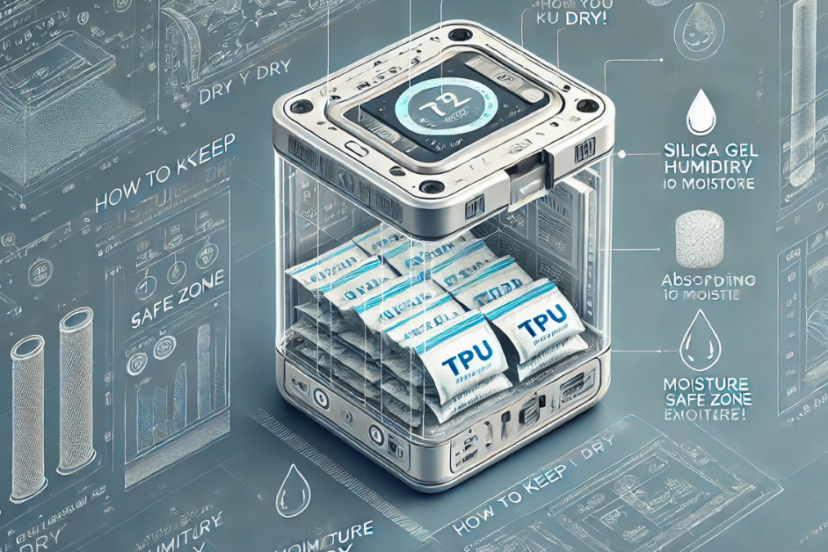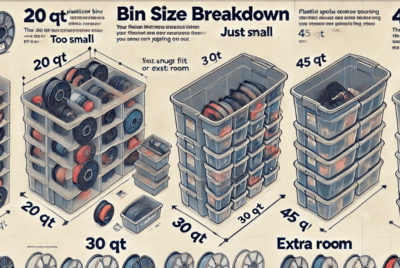How do I store TPU filament?
Storing TPU (Thermoplastic Polyurethane) filament properly is crucial to maintaining its quality and ensuring successful 3D prints. TPU is less hygroscopic compared to some other filaments like Nylon, but it can still absorb moisture, which can lead to printing issues such as poor adhesion, stringing, and weak prints. Here’s how you can store TPU filament to keep it in the best condition:
1. Store TPU in Airtight Containers
- Why It Helps: Airtight containers protect TPU filament from moisture, dust, and contaminants that could affect its printing performance.
- How to Do It:
- Use plastic bins or boxes with tight-fitting lids to store your filament.
- For additional protection, add desiccant packets (such as silica gel or clay desiccants) inside the container to absorb any moisture.
- Benefit: Keeps moisture and air out, preserving the filament’s quality.
2. Use Vacuum-Sealed Bags
- Why It Helps: Vacuum-sealed bags are an effective way to remove air and prevent moisture from entering, especially during long-term storage.
- How to Do It:Place your TPU filament spool in a vacuum-sealed bag, along with desiccant packets.
- Use a vacuum sealer to remove the air and seal the bag.
- Benefit: Moisture and oxygen are kept out, which is ideal for long-term storage and maintaining the filament’s condition.
3. Store in a Dry, Climate-Controlled Environment
- Why It Helps: Keeping TPU filament in a stable, dry environment prevents it from absorbing moisture from the air, which can lead to printing issues.
- How to Do It:
- Store TPU in a cool, dry location with consistent temperature and low humidity (ideally below 50%).
- Avoid storing it in places with fluctuating temperatures or high humidity, such as basements, bathrooms, or near windows.
- Benefit: A consistent, dry environment reduces the risk of moisture absorption and ensures your filament stays in optimal condition.
4. Use a Filament Dry Box
- Why It Helps: A filament dry box is designed to protect filament from moisture while you’re using it for printing. Some dry boxes also have built-in desiccants or temperature control to keep the filament at the ideal humidity level.
- How to Do It:
- Place the TPU filament spool in a dry box that includes desiccants or a built-in heating element to reduce humidity.
- Ensure the dry box is airtight to keep out moisture.
- Benefit: Keeps TPU filament dry while printing and during storage, which is especially helpful in high-humidity environments.
5. Avoid Direct Sunlight and Heat
- Why It Helps: TPU is sensitive to UV light and heat, which can degrade the material, making it more brittle and less flexible.
- How to Do It:
- Store TPU filament in opaque containers or vacuum-sealed bags to protect it from UV light.
- Keep the filament away from direct sunlight and heat sources such as radiators or ovens.
- Benefit: Prevents degradation of the filament, maintaining its flexibility and strength.
6. Use Desiccant Packs
- Why It Helps: TPU can absorb moisture over time, even though it’s less hygroscopic than some other materials. Using desiccant packs inside storage containers helps maintain a dry environment.
- How to Do It:
- Place silica gel or other desiccant packs inside the storage container or vacuum-sealed bag with the TPU filament spool.
- Replace or dry out the desiccants periodically to ensure they continue to absorb moisture.
- Benefit: Ensures that the filament stays dry, especially in humid environments.
7. Avoid Storing TPU in High Humidity Areas
- Why It Helps: Excessive humidity can lead to moisture absorption, causing the filament to become less flexible and leading to print quality issues.
- How to Do It:
- Keep TPU filament away from areas with high humidity, such as bathrooms, basements, or kitchens.
- Store filament in a room with low humidity and temperature control.
- Benefit: Prevents the filament from absorbing moisture and ensures better print quality.
Summary
To store TPU filament effectively, keep it in airtight containers or vacuum-sealed bags with desiccant packs, and store it in a dry, cool, and stable environment. Using a filament dry box with humidity control or desiccants can also help keep the filament dry while printing. Avoid exposing TPU to direct sunlight or heat, and make sure to store it away from high-humidity areas to maintain its flexibility and prevent moisture-related printing issues.




